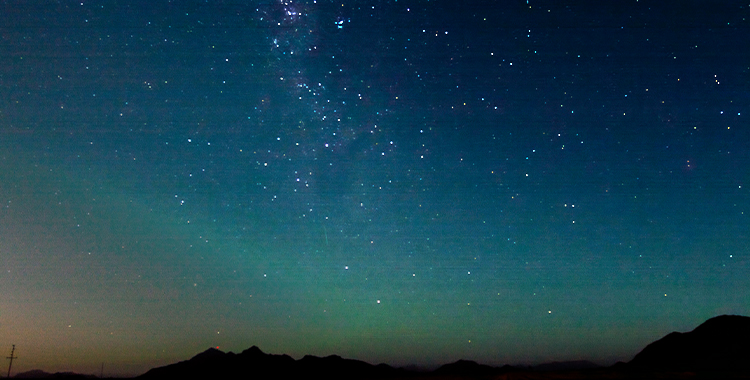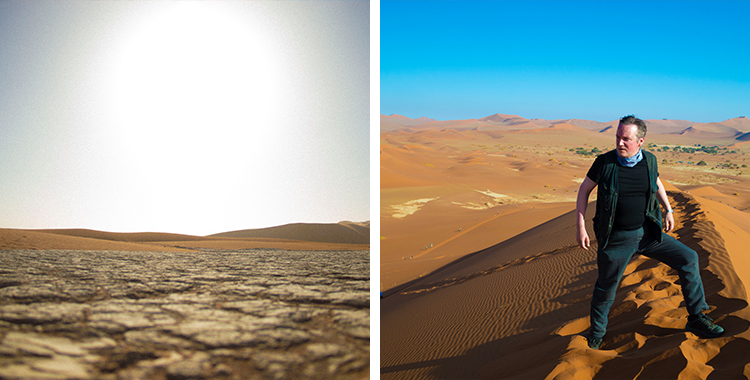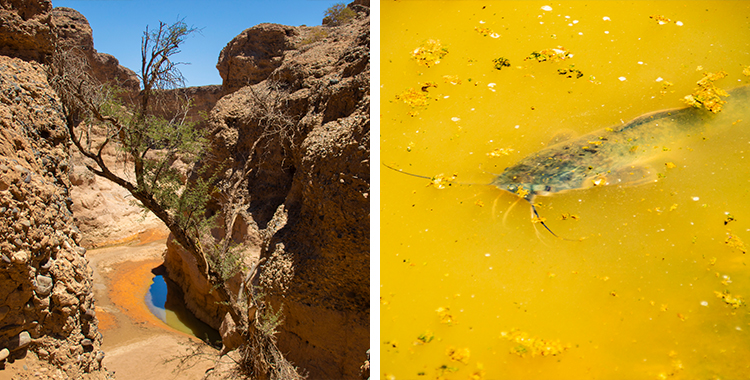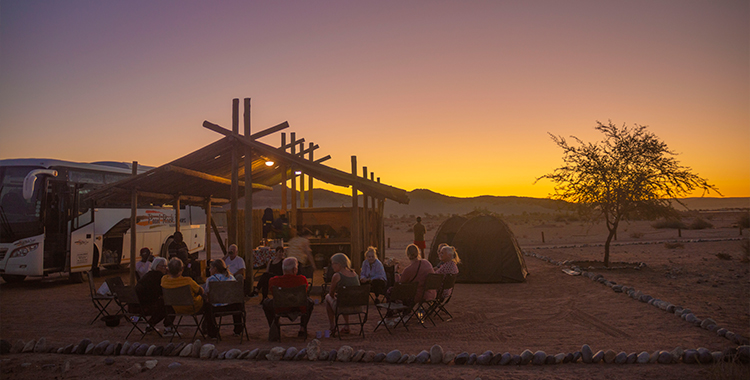I chose to visit Namibia because of a specific spot in the desert. I follow a lot of photographers on social media, and a couple of them posted photos from one of the most surreal landscapes I’ve ever seen. Whatever else I did, I simply had to witness it for myself.
Brace yourselves folks, I’m going to get incredibly nerdy…

Right: making a remote-controlled toy car with whatever you can find.
Our start to the day was a bit more relaxed; grit from the unsealed roads on our way to Keetmanshoop had interfered with a valve on the bus’s air brake system, so a quick repair was called for while we had a leisurely breakfast. Our journey was a long, direct drive with only minor stops for toilets or quick bites to eat. As before, the landscapes were endless and monotonous, through increasingly dry, rocky desert – and you, lucky reader, only have to skip to the next paragraph…
We travelled from Keetmanshoop on the Sunday that Namibia’s deceased president, Hage Geingob, was buried. In the towns we passed through, many people were dressed in their Sunday best for church. From a tour group perspective it was hard to gauge public opinion; naturally the local media respectfully presented him as a popular and powerful figure, but I didn’t get a sense of the saturation of state-backed mourning we experienced in the UK when the Queen died (my take on that here).
Certainly, Hage Geingob was impressive and highly educated: having grown up during South African apartheid and working for the United Nations, he was instrumental in Namibia’s independence from South Africa and served as Namibia’s first prime minister; he championed conservation and tourism (but also let China start buying up the country); he allowed free speech and a free press (and therefore had to allow criticism of himself and his government); and as a member of the minority Damara population, he could present his government as being more inclusive (most of the SWAPO political party come from the more prevalent, northern, Ovambo population).
And for pretty much everyone in the UK, we didn’t hear a single thing about any of this.
We arrived at Sossus Oasis Camp Site in the late afternoon. After a demonstration of how to put our tents up, Johannes started making our food while we all fumbled about with them. Following a swift sunset and dinner (an African-themed pasta dish), I took out my camera tripod to get some starry photos.
For a short while between darkening after sunset and before moonrise, the skies were perfect.
I saw constellations I hadn’t seen since my couple of years in New Zealand and Australia. I could see the Milky Way stretching overhead from horizon to horizon. And I proved my nerd credentials by identifying some of these constellations (confirmed by astronomy apps on phones).
Having taken plenty of star photos before, I found it was more rewarding to lend out my tripod to others in the group and helping them get the right settings on their cameras for astrophotography and shots of the low, near-full moon as it rose.

There is no southern ‘pole star’ like the northern hemisphere, but if there was, it would be a quarter of the way in from the right and a quarter of the way down from the top. From where we are, the stars appear to spin clockwise around this spot.
The bright star found almost a quarter of the way up from bottom-centre is Alpha Centauri, which actually consists of two sun-like stars (‘A’ and ‘B’) and a much smaller, fainter companion called Proxima, which is the second-closest star to Earth, after our own Sun.
[I was dead pleased with myself to get all these in one shot!]
We retired to our tents for the night. Those with sharp, attentive hearing could make out the weird croaky, chirrupy noises of desert geckos, or the yelps and snarls of jackals daring to come close to the camp as they foraged for discarded scraps of food.
You had to have sharp attentive hearing, to make anything out over all the snoring. Sweet, muscular Jesus, the snoring! I’m convinced some of my fellow travellers slept so deeply they could be eaten alive and the first they’d know of it would be inside an animal’s stomach. From around the nearby tents I heard sounds such as:
- sawing through a block of wood covered in macaroni cheese;
- a bluebottle on a moped;
- a helicopter flying over a pig farm;
- a warthog gently farting on a rusty seesaw;
- Donald Duck and Daffy Duck engaging in vigorous hate-sex.
I plugged in my headphones and listened to music all night instead. The next day, when I described the noises, everyone had fun* guessing whose snore was whose…
*(for a given value of ‘fun’, of course!)
(See more photos from the journey into the Namib Desert here.)
I got up early to wash and put in my contact lenses. Johannes was already preparing breakfast, since about 4am. The pre-dawn breakfast was necessary so we could join the queue to get into the park by 6.45am.
Unlike parks in the UK – where the word conjures up images of trees and grass and maybe a pond – this park contained only sparse vegetation, maybe the odd Camel Thorn Tree with roots stretching metres underground to reach the water table.
We transferred from our bus to a rickety tractor-trailer which bounced and swayed over the dried-up riverbeds in a way that made for a great spinal exercise. It did wonders for my pelvic tilt, anyway.

Right: despite being called ‘Deadvlei’, there is life around here…
As the early morning temperature rose perceptibly, Johannes gave us an explanation of how winds from the South Atlantic blew the sand dunes further inland in long north-south lines. Rain doesn’t fall here; the only moisture in the air comes from early-morning mist rolling in all the way from the ocean, sufficient only to be caught by insects and spiders (which are, in turn, caught by reptiles).
Rain that falls even further inland to the east or north eventually streams into the desert where the water simply stops and pools up in short-lived marshes, which become wet and green enough to attract pelicans and other wildlife. Given enough time, the migrating dunes cut off these marshes from the streams, leaving dead salt flats.
I was impatient to start climbing the dunes. I have a habit of charging up things like this and then crawling on my hands and knees by the time I get to the top, so I decided to pace myself, climb only one dune, and then head back down to the salt flats.
When I was about eight or nine years old I got The Usborne Book Of Survival Skills, which contained useful nuggets of information that I was certain I would never use, but somehow lodged in my memory anyway. And now, nearly forty years later, I finally found a use for the bits about surviving in the desert, such as breathing in through the mouth and out through the nose. (A lot of this information probably got mixed up with memories of reading Frank Herbert’s Dune, as well…)
My inner eight-year-old was geeking out (and also very surprised that my middle-aged carcass was doing this sort of thing). I’ve come to realise that most of my travels are all about indulging my inner child. Blame many, many hours of reading Tintin books.
Climbing these dunes was one of the things I most wanted from the trip. The vivid orange colour comes, essentially, from rust. The contrast with the deep blue sky was incredible. It was in this sort of Namibian scenery that portions of Mad Max: Fury Road (2015) were filmed.
Long-time readers will be aware that I’ve often travelled to places linked to my favourite films, and I’ll dress up accordingly (such as Star Trek, Star Wars, and Indiana Jones). I didn’t have anything post-apocalyptic, but I figured I could put on some dark clothes at the top of the dune, give my best squinty-eyed look of heroism, and make do… (judge for yourself).

It was, as expected, hot and dusty and it sucked the moisture out of my mouth like my earliest ever attempts at making scones. I hoped the snood I’d bought would help, but I honestly have no idea if it made any difference at all. The dunes were smooth on one side and gently rippled on the other. Along the ripple-side of each ridge you could spot lizard tracks, and the smaller, fainter dimples of spider steps.
I watched one of my fellow travellers attempt to scoot down the steep dune on her backside (gaining a pantload of sand in the process), and instead opted to stride down with all the confidence of a former public schoolboy running for high office. My pants remained sand-free, but I carried half the desert in my shoes.

Deadvlei was the reason I came to Namibia.
I hadn’t known about it as long as other locales I’ve visited, but something about it reminds me of the Salvador Dali landscapes I enjoyed poring over when I was a kid: the stark, plain ground; the simple and striking colours; the dead, dark, brittle trees. Hang a couple of melting clocks here and you’re sorted!
It’s the most surreal place I’ve ever stood in.
The vast, orange dunes surround Deadvlei like an amphitheatre. The highest of these goes by the name ‘Big Daddy’, and two of our group opted to climb all the way (Willem, Gert, we salute you). People look like no more than dark specks from below. The salt flat is maybe half a kilometre side to side, and the peak of the dune a kilometre beyond the desiccated trees.
It’s impossible not to get good photos here. I happily lay on the baked salt and clay to get the shots I wanted. What’s an adventure for, if you’re not going to get covered in dust?

Right: …and this is the closest to Mars I’ll ever get.
On the way back, staying at ground level, I was struck by the similarity between this place and the photos from the various Mars probes and rovers; it was almost identical (apart from the colour of the sky).
I’ve attended talks by people who worked on those probes. Now I was in the most Martian environment I was ever likely to visit. This, too, made my inner child geek out.

Right: not sure, but I think these are Sociable Weaver birds. They were definitely hungry, I’m pretty sure about that though.
We waited in the shade of a tree for the others to return. Nearby were Camel Thorn Trees, named after the Afrikaans word for ‘giraffe’ which eats the leaves from the top branches. These trees produce flat, crescent-shaped fruits (I have no idea what wildlife exists nearby that would eat these), while humans use the seeds to brew some sort of coffee, or crush them to treat ear infections. Boiling and brewing the roots can help toothache and tuberculosis, apparently, and I can only imagine how many generations of desperate experimentation led to those discoveries…
Our tractor-trailer ride back to the bus was interrupted when a tyre blew out. I joined a handful of others on a regular shuttle truck which sped us back to our air-conditioned bus before the ones who stayed aboard. I told our driver Barry that everyone else was lost and we were the only ones left, so he should just drive off.
The temperature was about 43C and not showing any signs of getting less hot…
Our next stop was Sesriem Canyon. It wasn’t anywhere near as large as Fish River Canyon, but it was large on a humanly-understood scale: high, narrow walls towered overhead; the walls were peppered with little round hollows where birds or snakes might find shelter. The canyon floor was carpeted with mud and shallow, stagnant pools.
In the green murk we could spot catfish swimming about the diminishing water.
By now, my own water had run out as well (I can’t remember how many litres I’d already gone through), and I felt a headache starting. Our ride to camp bounced over a rutted, corrugated track, which didn’t help…
Back at camp, I mentioned that I thought I might have a bit of heatstroke and before I knew it, retired nurse Nettie had me lying in the shade with a wet cloth on my head. I spent the afternoon reassuring passers-by that I was okay (and from later conversations it seemed pretty clear that a lot of other people probably had a bit of heatstroke too). This is not a condition one encounters in Scotland.
I was joined on my mattress by an inquisitive gecko (it might have been after a sip from my warm can of Sprite), and I’d gladly have stayed and entertained it, but the wind was blowing sand up my nose and I was getting bored, so I discharged myself (from the impromptu ‘hospital’ I mean, you dirty buggers), and went to sit in the shade at a nearby shop where there was air-con and cold drinks and dehydration tablets. The temperature peaked at 45C at about 4pm.
After another of Johannes’ African meals (a family recipe this time: a ratatouille-like sauce; a cabbage & peanut butter mixture; fruit halves filled with sweetcorn and cheese; and grilled meats), Willem provided fireside music on his guitar and we sang Bob Dylan songs and half-remembered lyrics to The Lion Sleeps Tonight. It was one of the most chilled-out and agreeable evenings I’ve had in ages.
That night, after packing up for the next day’s early departure, everyone settled into their tents and I can report that I didn’t hear any snoring sounds like the previous night.
No, no, no; this time the sound was more like someone endlessly running a chainsaw through a cat…
To be continued! (See more of my photos from the desert here.)









Pingback: Into Namibia 4: sun, sea, sand | Observaterry·
Pingback: Into Namibia 5: safari, so good | Observaterry·